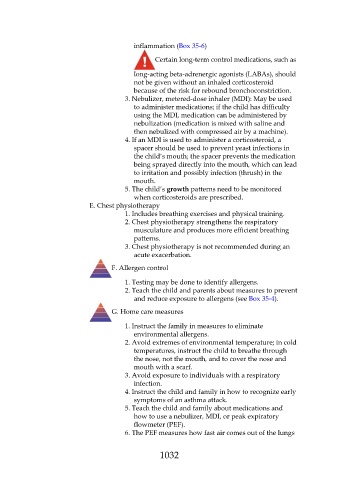Page 1032 - Saunders Comprehensive Review For NCLEX-RN
P. 1032
inflammation (Box 35-6)
Certain long-term control medications, such as
long-acting beta-adrenergic agonists (LABAs), should
not be given without an inhaled corticosteroid
because of the risk for rebound bronchoconstriction.
3. Nebulizer, metered-dose inhaler (MDI): May be used
to administer medications; if the child has difficulty
using the MDI, medication can be administered by
nebulization (medication is mixed with saline and
then nebulized with compressed air by a machine).
4. If an MDI is used to administer a corticosteroid, a
spacer should be used to prevent yeast infections in
the child’s mouth; the spacer prevents the medication
being sprayed directly into the mouth, which can lead
to irritation and possibly infection (thrush) in the
mouth.
5. The child’s growth patterns need to be monitored
when corticosteroids are prescribed.
E. Chest physiotherapy
1. Includes breathing exercises and physical training.
2. Chest physiotherapy strengthens the respiratory
musculature and produces more efficient breathing
patterns.
3. Chest physiotherapy is not recommended during an
acute exacerbation.
F. Allergen control
1. Testing may be done to identify allergens.
2. Teach the child and parents about measures to prevent
and reduce exposure to allergens (see Box 35-4).
G. Home care measures
1. Instruct the family in measures to eliminate
environmental allergens.
2. Avoid extremes of environmental temperature; in cold
temperatures, instruct the child to breathe through
the nose, not the mouth, and to cover the nose and
mouth with a scarf.
3. Avoid exposure to individuals with a respiratory
infection.
4. Instruct the child and family in how to recognize early
symptoms of an asthma attack.
5. Teach the child and family about medications and
how to use a nebulizer, MDI, or peak expiratory
flowmeter (PEF).
6. The PEF measures how fast air comes out of the lungs
1032

